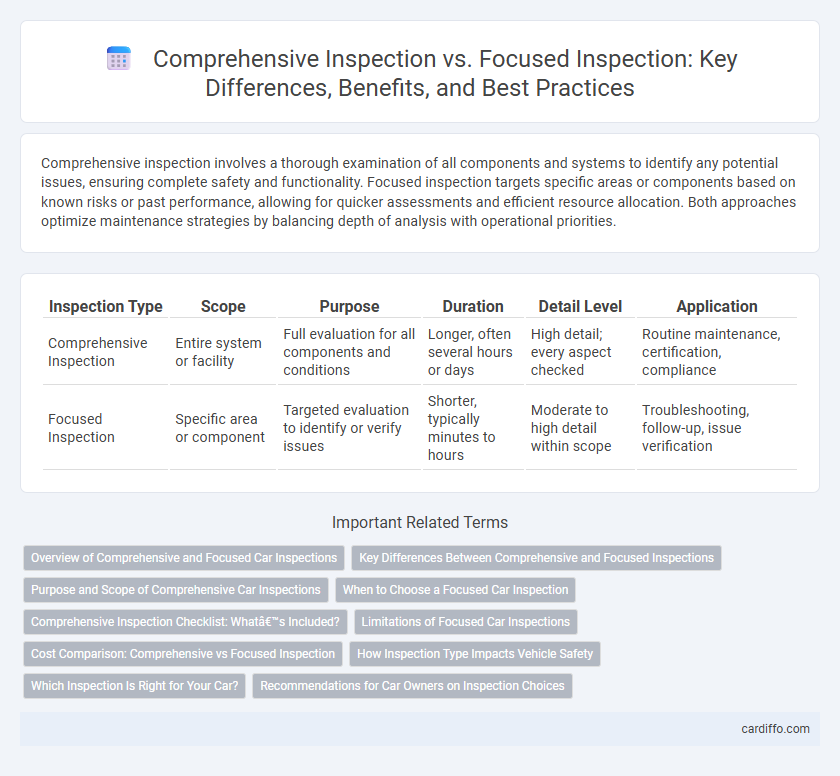Comprehensive inspection involves a thorough examination of all components and systems to identify any potential issues, ensuring complete safety and functionality. Focused inspection targets specific areas or components based on known risks or past performance, allowing for quicker assessments and efficient resource allocation. Both approaches optimize maintenance strategies by balancing depth of analysis with operational priorities.
Table of Comparison
| Inspection Type | Scope | Purpose | Duration | Detail Level | Application |
|---|---|---|---|---|---|
| Comprehensive Inspection | Entire system or facility | Full evaluation for all components and conditions | Longer, often several hours or days | High detail; every aspect checked | Routine maintenance, certification, compliance |
| Focused Inspection | Specific area or component | Targeted evaluation to identify or verify issues | Shorter, typically minutes to hours | Moderate to high detail within scope | Troubleshooting, follow-up, issue verification |
Overview of Comprehensive and Focused Car Inspections
Comprehensive car inspections evaluate a vehicle's overall condition, covering mechanical, electrical, safety, and cosmetic aspects to provide a detailed assessment of its performance and potential issues. Focused inspections target specific components or systems, such as brakes or engine performance, allowing for efficient identification of problems within particular areas. Choosing between comprehensive and focused inspections depends on the buyer's needs, with comprehensive offering a full overview and focused inspections providing targeted diagnostics.
Key Differences Between Comprehensive and Focused Inspections
Comprehensive inspections cover all aspects of a system or facility, providing a thorough evaluation of every component, whereas focused inspections target specific areas or issues based on prior risk assessment or known concerns. Comprehensive inspections typically require more time and resources, incorporating detailed checklists and extensive testing, while focused inspections prioritize efficiency and address critical points to mitigate immediate risks. Key differences also include the scope of inspection data collected--comprehensive inspections yield broad insights for long-term maintenance, whereas focused inspections aim for quick problem identification and resolution.
Purpose and Scope of Comprehensive Car Inspections
Comprehensive car inspections aim to evaluate the overall condition of a vehicle, covering mechanical, electrical, and safety systems to provide a thorough assessment. This type of inspection identifies potential issues across all major components, ensuring buyers or owners understand the vehicle's full status before purchase or maintenance decisions. In contrast, focused inspections target specific areas or concerns, offering a limited scope analysis tailored to particular needs.
When to Choose a Focused Car Inspection
Choose a focused car inspection when you need a targeted evaluation of specific vehicle components such as brakes, tires, or the engine, especially after noticing performance issues or following accident repairs. Focused inspections save time and cost by concentrating on potential problem areas rather than conducting a full vehicle assessment. This approach is ideal for routine maintenance checks or diagnosing particular concerns without inspecting the entire vehicle system.
Comprehensive Inspection Checklist: What’s Included?
A comprehensive inspection checklist typically includes a detailed assessment of structural integrity, electrical systems, plumbing, HVAC, and safety features to ensure all components meet regulatory standards and function correctly. This type of inspection covers both visible and hidden elements, such as roof condition, foundation stability, insulation, and potential environmental hazards. Detailed documentation of findings, photographs, and recommendations for repairs or maintenance are integral parts of the comprehensive inspection process.
Limitations of Focused Car Inspections
Focused car inspections prioritize specific components or systems, which can lead to overlooked issues outside the targeted areas, reducing overall vehicle safety assurance. These inspections often miss underlying problems such as frame damage, rust in uninspected sections, or hidden mechanical faults that comprehensive inspections would detect. The limited scope of focused inspections may result in unexpected repair costs and decreased vehicle reliability over time.
Cost Comparison: Comprehensive vs Focused Inspection
Comprehensive inspections involve thorough evaluations that cover all components, typically resulting in higher labor and equipment costs due to the extensive time and resources required. Focused inspections target specific areas or known issues, minimizing expenses by reducing scope and inspection duration while maintaining critical quality checks. Businesses optimize budgets by selecting focused inspections for routine assessments and comprehensive inspections when detailed analysis is essential.
How Inspection Type Impacts Vehicle Safety
Comprehensive inspections evaluate the entire vehicle, identifying underlying mechanical issues that might compromise safety, such as brake wear or suspension problems. Focused inspections target specific systems or components, streamlining the process but potentially overlooking other critical safety risks. The choice between inspection types directly impacts vehicle safety by determining the depth and scope of hazard detection.
Which Inspection Is Right for Your Car?
Choosing the right inspection for your car depends on its age, condition, and any specific issues you may be experiencing. Comprehensive inspections provide a thorough evaluation of all vehicle systems, ideal for older cars or before long trips, while focused inspections target particular areas such as brakes or engine performance, suitable for addressing known problems or routine maintenance. Understanding your car's history and symptoms helps determine whether a broad or specialized inspection will best ensure safety and reliability.
Recommendations for Car Owners on Inspection Choices
Car owners should choose a comprehensive inspection for thorough evaluation of all vehicle systems, including engine, brakes, suspension, and electrical components, ensuring early detection of potential issues. Focused inspections are ideal for targeting specific concerns like brake performance or fluid leaks, offering a quicker and cost-effective solution when the problem is well-identified. Regular comprehensive inspections every 12,000 miles combined with focused inspections based on warning signs can optimize vehicle safety and maintenance budgets.
Comprehensive Inspection vs Focused Inspection Infographic

 cardiffo.com
cardiffo.com